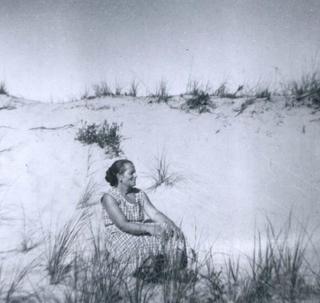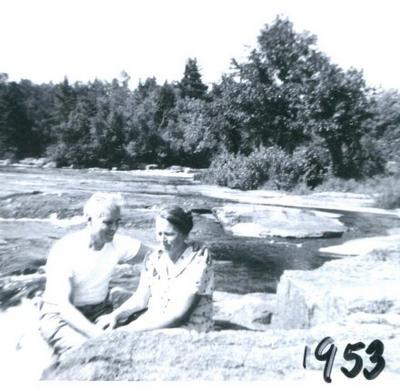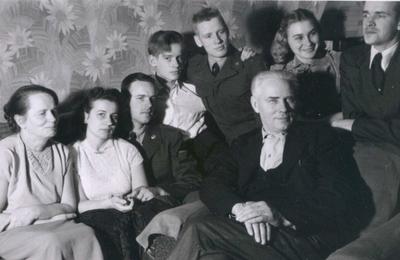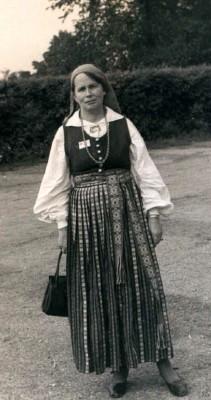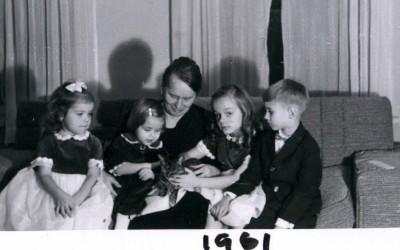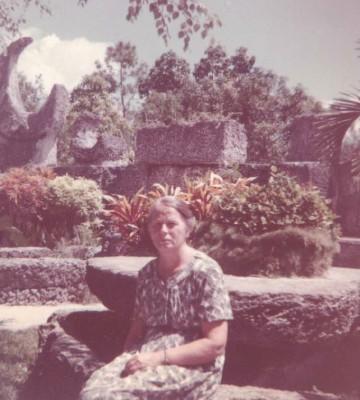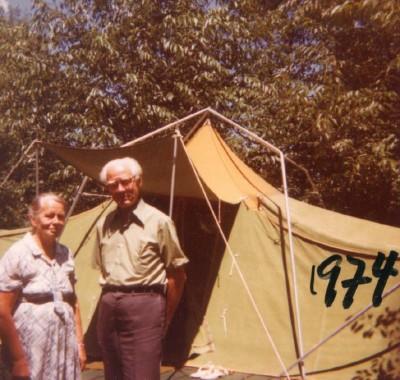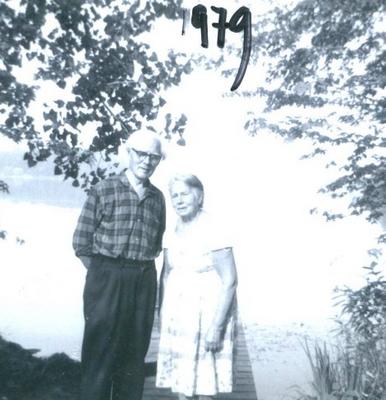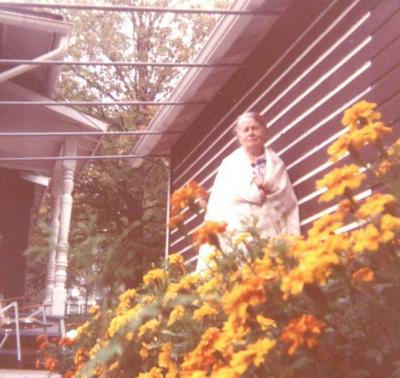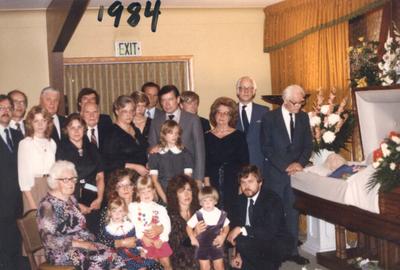by Zinta Aistars Kalamazoo College's new president, Dr. Eileen Wilson-Oyelaran, has moved into her office. The power of her leadership is a matter of place and story. Published in the Summer 2005 issue of LuxEsto, the College alumni magazine."We must tell our story of transforming lives."
Kalamazoo College's new president, Dr. Eileen Wilson-Oyelaran, has moved into her office. The power of her leadership is a matter of place and story. Published in the Summer 2005 issue of LuxEsto, the College alumni magazine."We must tell our story of transforming lives."--Eileen Wilson-Oyelaran
The red brick buildings, the grand white colonnades, the front steps leading down to a cobblestone road called Academy Street—these are uncannily similar at Salem College and Kalamazoo College. Dr. Eileen Wilson-Oyelaran won't even have to change addresses. Her office was and is on Academy Street.
There is this difference: on the door of her office at Salem College (Winston-Salem, North Carolina), the plaque says: Vice President and Dean of the College; on the door of her office in Mandelle Hall at Kalamazoo College, the plaque reads: President.
On December 11, 2004, the Board of Trustees of Kalamazoo College unanimously elected Dr. Eileen Wilson-Oyelaran the 17th president, the first woman president, and the first African-American president, of Kalamazoo College. She moved to the Academy Street office at Kalamazoo College last month.
"From one good place to another good place," Eileen says. “The power of place…” and her thoughts veer towards making connections, to crossing borders, and about the manner in which education allows us to pass beyond our personal boundaries to ever new and changing places.
It may be that the similarities of these two places—Salem College and Kalamazoo College—in the life and career of Eileen Wilson-Oyelaran far outweigh the differences. Like Kalamazoo, Salem College is a small, residential liberal arts college, founded more than two centuries ago. Like the Kalamazoo Plan, integrating rigorous academics, career development programs, study abroad, and a senior individualized project, Salem College has its Salem Signature Program, building leadership skills through internships, journaling for self-exploration, and an array of outreach programs. Both schools give top priority to teaching their students to be lifelong learners, and both encourage them to never be limited by the border of any one place.
Eileen sees the similarities: "Salem and Kalamazoo College share a deep commitment that begins in the classroom and goes beyond it. What we learn in these institutions is grounded in the academic world, but practical in the world outside. The focus is on greater values, on having a global perspective, and on being a citizen of a diverse global community."
Eileen says there comes a time to leave one's accustomed place and move forward, to embrace change, and to seek new challenges. Kalamazoo College was that calling. "I had heard about Kalamazoo," she says, "and I was aware of the strong reputation of this institution. I have been reading the history of Kalamazoo College, and I've met with people who represent this college—because it is the people who give the true st sense of what a place is—and with each meeting grew my conviction: Kalamazoo College and I, we fit."
Board of Trustees, faculty, staff, and students, individually and in groups, have met with the new president, and they agree: the fit is right. Education has always been Eileen Wilson-Oyelaran’s passport to move from one good place to another. Her dedication to excellence in education has led her to her new home.
Born in Los Angeles, California, Eileen earned her B.A. in sociology from Pomona College, an M.A. and Ph.D. in education from the Claremont Graduate University in California. She served as associate professor and chair of the department of education at Winston-Salem State University, and she was visiting scholar in education at North Carolina Wesleyan College. She taught in the departments of education and psychology at the University of Ife (now Obafemi Awolowo University) in Nigeria for 14 years and served as acting head of the department of psychology there for five years. While in Nigeria she was a consultant for UNICEF (Nigeria) in the area of early childhood development. In 1995, she became Dean of the College at Salem College, and later rose to the position of Vice President and Dean of the College for Salem Academy and College. She served as acting president of the institution from November 2003 to March 2004, during the sabbatical of Salem's president Julianne Still Thrift.
"I grew up in a family that placed great importance on education," she says of her childhood in southern California, where her parents, Welford and Juanita Wilson, raised her and her sister Carol. "We were privileged to go to the best primary schools where we were taught to meet the highest expectations. Our teachers remained in contact with us through our college years, like members of our family, guiding our way."
Her study abroad experience, she smiles, was only a partial stretch of her comfort zone. She chose England "because I spoke the language." But the experience was a critical one, and Eileen's work there with immigrant children from West Africa, South Africa, and the Caribbean, determined her lifelong scholarly interest in child development and multicultural education.
"The experience was transformative," she says. "I left England committed to understanding a wider world, fascinated with the notion of the African Diaspora, and determined to travel and study abroad more extensively."
Eileen firmly decided that her next trip was to be to Africa, and that she would not allow language to be a barrier. Upon graduating from Pomona College, she was awarded a Thomas J. Watson Traveling Fellowship that allowed her to spend 16 months traveling and studying in Ghana, Nigeria, and Tanzania, developing curriculum materials for students in the United States. No less important on study abroad were the adventures outside of academic curriculum, and so Eileen took time to climb Mount Kilimanjaro in Kenya and to explore the Dogon villages in Mali, West Africa.
"From these study abroad experiences coalesced my appreciation for the power of cross-cultural study and my commitment to foster a more international focus on our school campuses and within the curriculum."
After completing her doctoral work in childhood development and early childhood education, Eileen accepted her first academic position at the University of Ife in Nigeria. Ife and Nigeria would be her career and her home for the next 14 years. By 1982, she was chairperson of the newly created department of psychology.
"Today's world is so much more connected than it was 30 years ago," she says. “I am a strong proponent of intercultural and international education; it is important not only to send our students out into the world, but to also build and strengthen a diverse community on our campuses. One of my top goals at Kalamazoo College is to more consciously and deeply integrate the experiences of our students abroad with experiences back on campus and in the Kalamazoo community. We need to understand the complexities of living and studying abroad and then apply that understanding to cultivate the full educational potential of students’ reintegrating themselves and what they have learned into their lives, communities, and culture.”
The world grows smaller. And growing larger is the importance of understanding people who see life from the standpoint of cultures and ethnic, racial, or religious backgrounds that differ from our own. In this state of change (characterized by excitement and stress) Eileen has built a reputation as “a gentle bridge builder,” according to a recent article in the Winston-Salem Journal. This aspect of her work has become her legacy and a continuing goal.
Eileen recalls hearing Martin Luther King speak when she was a child. His words took root in her. “You can’t live the dream if you don’t know it,” she says. Cross-cultural education is the means of knowing the dreams of others, a bridge built by an immersion that involving the mind, the body, and the spirit. That bridge, in turn, helps build a more understanding and tolerant society.
“I am drawn to Kalamazoo College for many reasons,” Eileen says, “but I am most intrigued by the College’s desire to develop ‘a culture and climate in which internationalism, multiculturism, and diversity flourish.’ I am also drawn to the commitment of Kalamazoo College to community and to the highest ethical standards, respect for all persons, and leadership with integrity. These are the values that resonate deeply with me. They are what I hope others would say my life has been about.”
Eileen’s awards and honors are legion. They include the Kent Fellowship and the Ford Foundation National Fellowship for graduate study; the Ada Mae Fitts Woman of the Year, awarded to the most outstanding senior woman by the Pomona College faculty; the Thomas J. Watson Traveling Fellowship, the Claremont College’s Black Studies Center Visionary Leadership Award, and the American Council on Education Fellowship, one of the most prestigious leadership training programs in higher education. She spent that fellowship year working with the president and provost of Wake Forest University. In 1999 she was awarded the Gender Equity Architect Award by the American Association of Colleges of Teacher Education in recognition of her work in leadership development and mentoring young women and girls. In 2002 the Salvation Army honored her with the Strong, Smart, Bold Award in recognition of her service to women and girls in Forsyth County, North Carolina.
At Kalamazoo, Eileen is eager to immerse herself in the College’s evolving vision of an excellent liberal arts education. She is eager to explore and extend the service learning and outreach programs that connect the College to the surrounding community. She talks about the importance of outreach: “We want to tell our liberal arts story to students in elementary and middle schools, so that when it is time for them to consider college, they will think of Kalamazoo.”
Eileen is concerned with the challenges that face small, liberal arts colleges, and she is eager to meet the challenge by calling the Kalamazoo College community to work alongside her.
"Small liberal arts colleges like Kalamazoo are losing their share of the educational market. In 1953, 29 percent of all undergraduate students attended small residential colleges. By 1993, that figure dropped to only 9 percent. At a time when Division I sports and large universities seem to be everything, we do not have the desirability or visibility of these institutions. We lack the large numbers of alumni. Parents and students are stunned by our tuition costs. Today, more than 75 percent of all full-time undergraduates attend a college or university that costs less than $8,000 per academic year. They want to know what the value will be of the additional dollars needed to attend Kalamazoo College.
"The entire Kalamazoo College community must do a better job explaining the added value of a liberal arts education,” says Eileen. “In an era of rapid change, we must explain the crucial difference that a liberal arts education at small residential colleges offers: the preparation for lifelong learning, the focus on the entire student, access to faculty, small, personal classes, and individualized attention. Our students are more likely to graduate within four years, and they are more likely to go on to complete advanced degrees. We have the capability to transform lives."
One of her roles as Kalamazoo College president is to be this storyteller, but she plans to involve the entire College community. "Who better to tell our story than those of us who have lived it? Our own students, especially as they return from their study abroad, our recent graduates, and our alumni can tell this story. Larger institutions are often 'branded' by their sports teams, but it is up to us to 'brand' our college for its excellent educational value."
Part of meeting this challenge, Eileen says, is the challenge to sustain and grow our endowment. To become an inclusive community and a diverse student body, "We have to find ways to finance any student who wishes to come to Kalamazoo College. Ten years from now, I would like to see the resources and the scholarships in place so that our campus is open to all."
Feeling welcome is also a matter of place. "We must improve our campus climate to match the excellence of our academic heart, which is the authentic and vital engagement between a great teacher and student. But we also need a heart of a social nature, and to help develop that we need comfortable and inviting campus spaces for students to gather and interact with each other. That, too, is a part of their educational experience."
Campus climate is one of several issues about which Eileen has heard from the Kalamazoo College community as she walks the campus and meets with students, faculty, staff, and alumni. She is listening closely. The strength of the College, she believes, is not only in the excellence of our academic programs, but also found in our living human resources.
"And that is how I lead," she says. "I begin to know a place and its people by listening. Before determining a course of action, I consult broadly, listen carefully, review all reliable data, and consider alternative possibilities. One of my strengths is the capacity to build consensus among individuals who hold differing perspectives without closing off the necessary, sometimes difficult, conversations. I am a strong proponent of shared governance, and I work always towards a vision that is jointly crafted. But when difficult decisions must be made, I can make them."
At the end of the day, Eileen Wilson-Oyelaran knows the value of rejuvenation. Her hands are full, she says, and there is much to do as she makes this new good place her own. Her family is her joy and support—husband Dr. Olasope Oyelaran, whom she fondly calls Sope (pronounced Soap-way), and their four adult children: Doyin, Oyinda, Salewa, Yinka. Raising her family is one of their proudest achievements, but now that the home nest is empty—"but for the occasional returning child," Eileen laughs. She makes time for yoga—"that time of day is not to be touched;" reading—"usually several books at once;" and, however rarely, a television show or two—"I love British comedy;" or even a bit of adventure—"I enjoy body surfing."
But the workday holds great promise, and Monday is a day she greets with enthusiasm at Kalamazoo College. When entering her new office on Academy Street, this time in Michigan, her smile broadens. "I am excited," she says simply, "by all that we can accomplish here together. Kalamazoo College is a great institution with tremendous potential. I am here to open doors and build bridges and welcome all to our campus that is but a small corner of the world. Let us move forward together to realize the Kalamazoo College we all imagine."
Success for Eileen Wilson-Oyelaran, she adds, works this way: "I am an old girl scout. I always try to leave a place better than I found it."
SIDEBAR - Name Talk: Sope's StoryDecember 2004What’s in a name? For some of us, a different sense of home.
Like the rest of the Kalamazoo College community, I am filled with excitement at the prospect of meeting our new “first family,” Eileen Wilson-Oyelaran and her husband, Olasope Oyelaran, wishing to welcome them to their new home. The announcement has gone out to the College community: we have a new president. Introductions have been made. A first presidential speech has been given, and the buzz is electric across the campus.
Taking a moment away from the many introductions, Eileen and Olasope Oyelaran sit down to lunch with a group of Kalamazoo College staff. An open seat beside him, Olasope nods to me to take it. “Call me Sope,” he says. Soh-pay, I repeat, trying out the pronunciation.
I extend my hand. “And mine is Zinta,” and our talk turns to our names—Sope and Zinta. Along with nuances of speech and dialect, unusual names are among the first clue that one is far from home. Sope’s home is a Nigerian village called Ajaawa, in Southwest Africa. Mine? –well, I am still looking for mine. My ethnic roots and one of my dual citizenships branch back to Latvia, a small country on the Baltic Sea, but I was born in the United States, daughter of two World War II refugees escaping the Soviet Army. My upbringing was firmly rooted in the Latvian culture and I attended private Latvian school on weekends and public school, where I learned English, on weekdays. When I was fifteen, I made my first trip overseas to feel the soil of my ancestors’ home beneath my feet. The immediate sense of coming home was powerful.
“And yet,” I said to Sope, “I was simultaneously homesick for this country, too. Wherever I am, I long for the place I am not.”
Sope nodded and smiled warmly with understanding. He and Eileen return to Nigeria whenever the opportunity arises—about every other year—and when it does not, “my family in the village is well connected with cell phones,” Sope chuckles.
Family, Sope tells me, is a tightly knit and supportive network. “So close you can’t see between them,” he says. “I was born into a large family, but not the kind of nuclear family as we define it here in the United States. We were many children raised by many mothers, fathers, aunts, uncles, and cousins.”
Sope’s family embraced education, even if it meant leaving home. The “westernized” school in Ajaawa was run by the Baptist church. Children moved from grammar school in the village to a “secondary school” in a larger community. If exams were passed satisfactorily, children moved on up to advanced schools called “Sixth Form” or university. Sope passed his exams, and he competed for scholarships that could open for him the road to the United States for further study.
“It was a very competitive program, and only 23 students out of a pool of some 3,000 persons won the scholarships. I was among them. I was the first from my family to study overseas. But with my family’s support, nothing could intimidate me. My grandfather’s sister was a powerful force in my family, and she considered education to be ‘an intellectual adventure.’ She encouraged me to go, learn, return, and bring what I had learned back to Ajaawa.”
A short distance from Salem College and Academy, where Eileen was Dean and Vice President, Dr. Olasope Oyelaran was Director of International Programs and associate professor of English. He speaks seven languages, holds a Ph.D. in linguistics from Stanford University, and, like his wife, is dedicated to cross-cultural education.
“I was invited to return to Nigeria in 1970 to build an authentically African institution of higher education,” he says. After years of study in the United States and in France, Sope returned to Nigeria to establish a department of African languages and literature, “thinking I was home safe,” as in unmarried, he chuckles. “So many who had studied abroad came home with wives from America or from Europe. I came home alone.”
Eileen, in Nigeria on the Thomas J. Watson Traveling Fellowship, met Sope on his own territory. They became close friends, and Eileen visited his village and quickly befriended Sope’s extended family there as well. “Everyone in the village was talking about Eileen, Eileen, Eileen. They all had fallen in love with Eileen,” Sope says, and it is clear that he, too, came to see this energetic and personable woman as far more than a friend. The two were married in 1980, and their intention was to build a life in Nigeria, pursuing careers in education. But new opportunities and the needs of Eileen’s aging parents brought the couple and their four children to North Carolina in 1988.
March 2005I again meet with Eileen and Sope, this time in Winston-Salem. Sope brings me to his office at Winston-Salem State University. The Office of International Programs is small but bustling with activity, photos on the walls from many of the 43 countries where Winston-Salem students study abroad. Sope has been a driving force in establishing the university’s international programs.
We are standing in the atrium of the Winston-Salem State University’s C.G. O’Kelly Library. Sope has brought me here to show me two immense murals on the wall, painted by John and James Biggers in the early 1990s. The murals represent an integration of knowledge from many academic disciplines: African mythology and folklore, mathematics, science, literature and American history, sociology and religion. The murals are stunning, and Sope is visibly moved by them. Watching him observe them and listening to him speak about them becomes, for me, a window into Sope’s heart.
He opens international doors to his students, and his own travels and studies frequently take him across the globe. So I ask Sope, “Where is home?” He smiles, then says: “Nigeria will always be home. Someday, we hope to return. But we go where there are new challenges to meet, where we can make a difference. We have done our work here in North Carolina, and now it is time to meet a new challenge. Eileen and I are very excited to be at Kalamazoo College, and we are both eager to make Kalamazoo our new home.”
For more information about Kalamazoo College, see www.kzoo.edu












